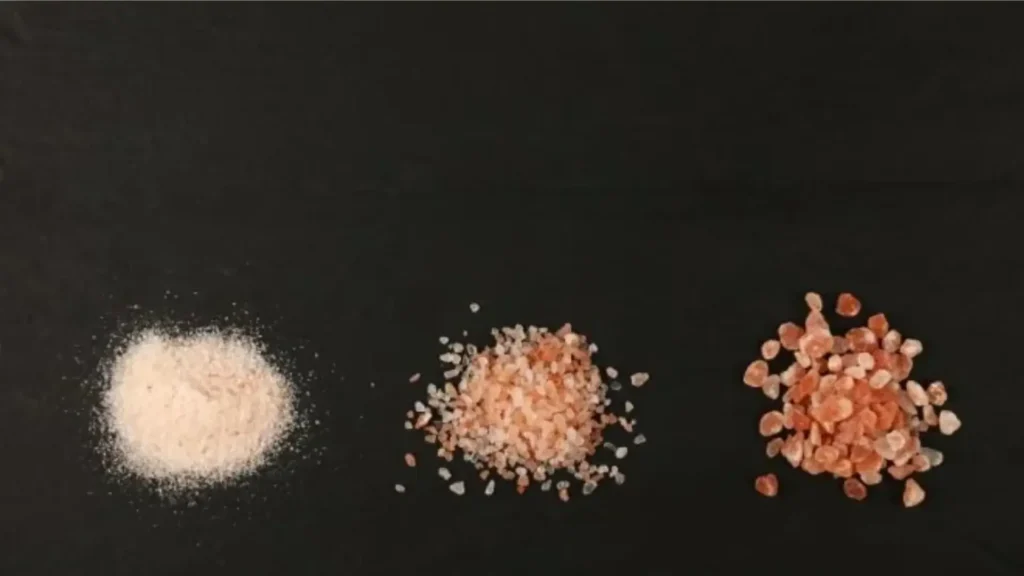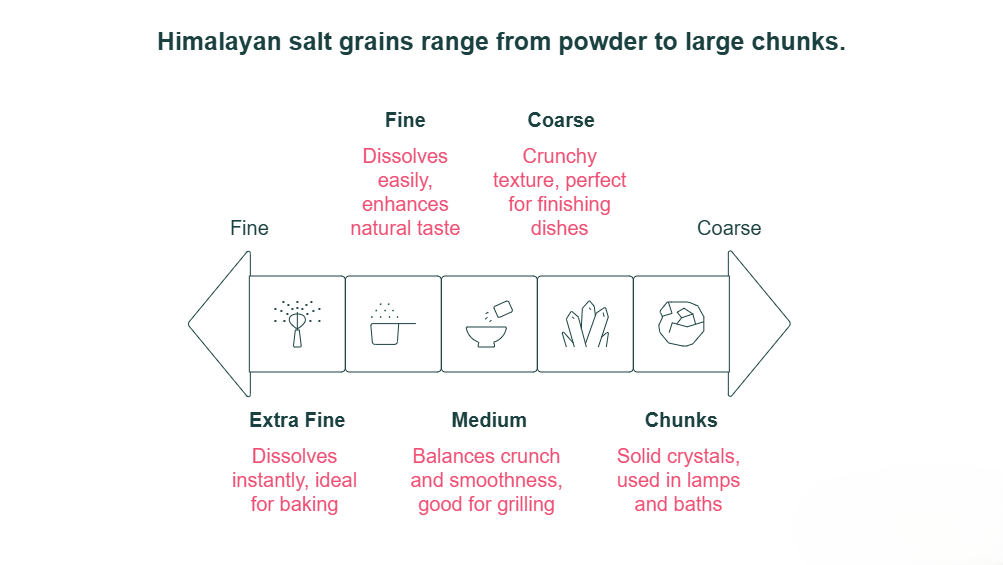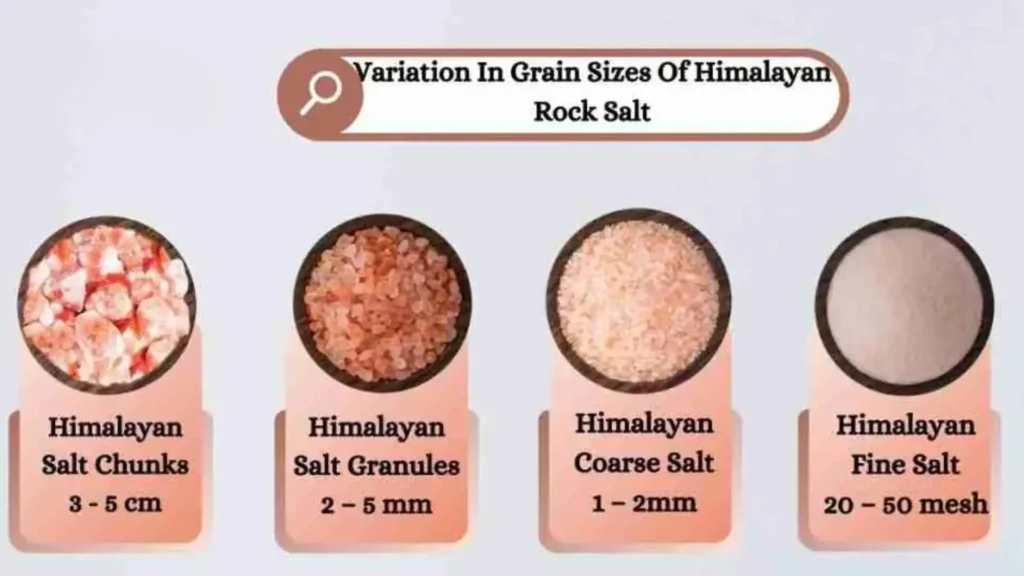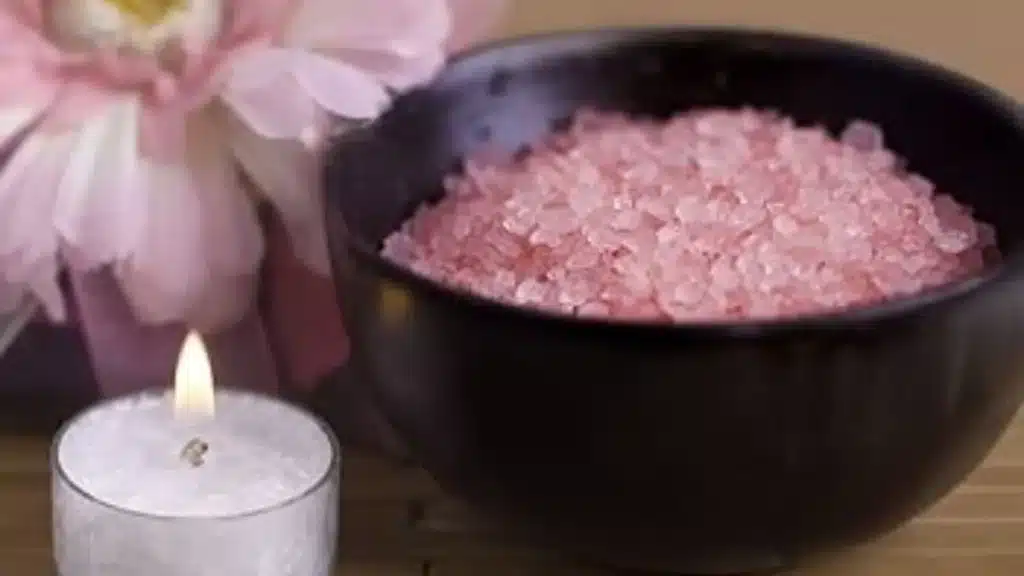Different Types of Grains in Himalayan Salt: Which One Should You Use and Why
- Zayan Rauf

Table of Contents
Himalayan salt isn’t just famous for its pink hue, it’s known for its natural purity, rich mineral content, and wide range of grain sizes that make it incredibly versatile. Whether you’re seasoning a meal, exfoliating your skin, or crafting a relaxing bath soak, the grain size of Himalayan salt makes all the difference.
Despite its exotic reputation, Himalayan pink salt is about 98% sodium chloride, just like regular table salt. Its color and charm come from tiny traces of over 84 minerals such as potassium, calcium, and iron that make up the remaining 2%. [1] These trace minerals don’t just give it that soft pink glow, they also enhance its overall natural appeal and wellness reputation.
But what exactly are the different types of grains in Himalayan salt, and how should you choose the right one? Let’s explore the beauty and purpose behind every crystal from fine powder to large rock chunks.

Why Do We Need Different Grains of Salt?
Not all salt is created equal especially when it comes to grain size. The grain of salt size (in mm) affects how quickly it dissolves, how it interacts with food, and even how it feels when used in skincare.
Here’s why grain size matters:
- Flavor Control: Fine grains dissolve faster and distribute saltiness evenly, while coarse grains offer bursts of flavor.
- Texture: Larger crystals add crunch and visual appeal.
- Usage Variety: Different grain sizes are suited for cooking, bathing, and decorative purposes.
- Solubility & Minerals: Finer grains release minerals like potassium, calcium, and magnesium more quickly.
If you’re watching your sodium intake, grain size can even make a measurable difference coarser Himalayan salt grains pack less densely, offering up to 20% less sodium per teaspoon (around 2,000 mg) than finer grains that contain roughly 2,300 mg. [2] It’s a simple way to enjoy flavor with slightly less sodium.
Exploring Different Types of Grains in Himalayan Salt
Below are the main grain types found in Himalayan pink salt each with its own unique purpose.

1. Extra Fine Himalayan Salt (0–0.5 mm)
This powder-like salt has the smallest grain size and dissolves almost instantly. It’s perfect for:
- Baking and precise seasoning
- Daily cooking and sprinkling
- Spa products like scrubs and masks
Its smooth texture makes it ideal for recipes where even salt distribution is crucial. Plus, its quick solubility helps you get a clean, mineral-rich taste in every bite.
Find Out: What Does Salt Do In Baking
How to Use Himalayan Salt for Cooking
2. Fine Himalayan Pink Salt (0.5–1 mm)
Fine Himalayan salt is a kitchen favorite. It’s slightly coarser than extra fine but still dissolves easily.
Perfect for:
- Everyday cooking
- Salad dressings and soups
- Table seasoning
This type enhances the natural taste of food without overpowering it. Its soft pink glow also hints at essential trace minerals such as magnesium and potassium making it both pretty and healthy.
Read About: Health Benefits Of Himalayan Pink Salt
Did You Know?
Each kilogram of Himalayan pink salt contains about 2,406 mg potassium, 2,695 mg calcium, and 2,655 mg magnesium more than typical table salt, but still small enough not to change your daily nutrition significantly. [3] Its soft color and natural minerals make it a healthy and aesthetic choice for any meal.
3. Medium Grain Himalayan Salt (1–2 mm)
Medium grains are the “all-rounders” of Himalayan salt. They strike a balance between crunch and smoothness.
Best used for:
- Grilling and roasting meats
- Pickling and brining
- Salt grinders and mills
Because of their density, medium grains infuse flavor slowly giving your dishes a steady, natural saltiness without overwhelming the taste.
4. Coarse Himalayan Pink Salt (2–4 mm)
Coarse Himalayan salt comes in larger, crystal-like grains that are ideal for:
- Finishing dishes
- Salt grinders
- Decorative table displays
Because coarse grains dissolve slowly, they maintain their crunch and enhance presentation. And if you’re mindful of sodium, this size can help reduce intake by volume. [4] It’s the perfect choice for finishing touches or grinding fresh flavor over food.
5. Himalayan Salt Chunks (Above 4 mm)
These are the biggest and boldest of all salt grains. Typically used in:
Large chunks contain natural minerals that slowly release into the air or water. They’re also popular for grilling seafood or vegetables on Himalayan salt slabs, adding both taste and wellness benefits.
Did You Know?
Large chunks release minerals slowly, enriching your environment or bathwater with natural ions. True Himalayan sources tend to contain around 55 mg more iron and 2,508 mg more potassium per kilogram than look-alike salts from other regions though they might also carry more aluminum. [5]
Comparison Table: Himalayan Salt Grain Sizes & Uses
Grain Type | Size (mm) | Best For | Texture & Dissolving Rate | Common Uses |
Extra Fine | 0–0.5 | Baking, beauty care | Very soft, dissolves instantly | Baked goods, face scrubs |
Fine | 0.5–1 | Cooking & table use | Smooth, dissolves quickly | Daily cooking, soups |
Medium | 1–2 | Grilling & pickling | Slight crunch, moderate dissolve | Brining, roasting |
Coarse | 2–4 | Finishing & grinding | Crunchy, slow dissolve | Finishing dishes, grinders |
Chunks | 4+ | Décor & wellness | Solid crystals | Lamps, slabs, baths |
How Many Types of Grains Are in Himalayan Salt?
Generally, there are five main grain types; extra fine, fine, medium, coarse, and chunks. However, within the salt industry, custom grain sizes can also be created for specialized uses like gourmet salts, spa treatments, and industrial applications.
Understanding the salt grain size chart helps consumers and manufacturers match the right type of salt to the right purpose whether culinary or therapeutic.
Explore: Types Of Salt For Cooking
Rock Salt Composition & Texture
Himalayan rock salt is 98–99% sodium chloride, with small traces of calcium, potassium, magnesium, and iron oxide, the mineral that gives it its iconic pink color.
Its natural rock salt composition and crystalline texture make it a healthier alternative to refined table salt, offering both taste and trace nutrients. However, the actual mineral contribution is quite small. For example, a teaspoon (about 5 grams) of Himalayan salt only provides around 12 mg of potassium, compared to the 2,800 mg you need daily. [6]
Read: What Is Rock Salt
Are There Any Himalayan Pink Salt Side Effects?

When used in moderation, Himalayan salt is safe and beneficial. However, excessive salt consumption of any type can increase blood pressure or water retention.
To stay healthy:
- Use Himalayan salt moderately
- Stay hydrated
- Avoid over-salting processed foods
Remember, balance is key even with natural salts.
Also Read: Side Effects Of Pink Himalayan Salt Bath
Conclusion
Himalayan salt comes in five main grain types, each offering its own unique use, flavor, and texture. The size of the grains affects how the salt dissolves, how intense the flavor feels, and even how visually appealing it looks on food or in wellness products. While finer grains are perfect for everyday cooking and seasoning, the coarse and chunky varieties bring decorative charm and therapeutic benefits. Rich in natural minerals, Himalayan salt supports wellness, enhances flavor, and adds natural beauty to your lifestyle. Choosing trusted brands like Sobaan Salts ensures you’re getting authentic, food-grade, and sustainably sourced salt. In short, understanding the different types of grains in Himalayan salt helps you make smarter, healthier, and more creative choices from kitchen recipes to self-care rituals. So the next time you reach for that pink crystal, think beyond taste, think Sobaan Salts.
References:
- Kuhn, T., Chytrý, P., Souza, G. M. S., Bauer, D. V., Amaral, L., & Dias, J. F. (2020). Signature of the Himalayan salt. Nuclear Instruments and Methods in Physics Research Section B: Beam Interactions with Materials and Atoms, 463, 250–253. Science Direct
- Ganguly, B., & Deori, B. G. (2025). Salt-making traditions and salt trade in the Eastern Himalayas. In Meridians of Salt (pp. 295–316). Springer.
- Bhonsle, S. J. (2011). Traditionally cultivated salt tolerant rice varieties grown in khazan lands (saline lands) [PDF]. CORE. Retrieved from https://core.ac.uk/download/pdf/236017683.pdf core.ac.uk
- Chander, V., et al. (2020). Structural characterization of Himalayan black rock salt by SEM, XRD and in-vitro antioxidant activity. Science of the Total Environment, (article S0048969720347987). Science Direct
Share This Post
Article By

